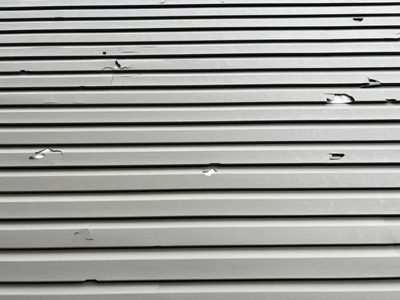Fort Collins, Colorado, is celebrated for its breathtaking natural landscapes, thriving community, and dynamic weather patterns. However, residents are all too familiar with the challenges posed by high winds, particularly during the spring months of March through May. These strong gusts can cause significant damage to homes, particularly their siding, leading to costly repairs and potential structural vulnerabilities. Understanding how wind affects your home's exterior is essential for maintaining its integrity and ensuring the safety of its occupants.
Wind Patterns in Fort Collins – What Homeowners Should Know
Fort Collins experiences considerable seasonal variations in wind speeds, with the windiest period typically spanning from November through April. During this time, average wind speeds often exceed 9.1 miles per hour, with January being the windiest month, averaging 11.3 miles per hour. While wind speeds tend to decrease as spring progresses, they can still pose a serious threat to home exteriors. For instance, on March 6, 2023, Fort Collins recorded a maximum wind speed of 18 mph, and on April 7, 2024, wind speeds peaked at 21 mph.
Homes in exposed areas, such as those near the foothills or open plains, are particularly vulnerable. In these locations, wind speeds can be amplified due to a lack of natural barriers, increasing the likelihood of siding damage. Strong winds can exploit existing weaknesses in siding materials, leading to issues such as cracking, warping, or complete detachment. Over time, even moderate but persistent winds can exacerbate these problems, emphasizing the importance of regular inspections and maintenance.
How Wind Affects Different Siding Materials
Different siding materials react uniquely to high winds. Understanding their vulnerabilities can help homeowners select appropriate materials and implement effective maintenance strategies.
- Vinyl Siding - This is a popular choice for its affordability and low maintenance, but it is susceptible to cracking, warping, or detachment in high winds. Wind-blown debris can also cause chipping or holes in vinyl siding, which can compromise its protective function.
- Wood Siding - While aesthetically pleasing, wood siding is prone to splitting or cracking under high wind pressure, especially if it is older or not well-maintained. Once damaged, wood can absorb moisture, leading to rot and further deterioration.
- Fiber Cement Siding - Known for its durability, fiber cement siding resists most weather conditions well. However, strong winds and flying debris can still cause cracks or breaks in the material.
- Metal Siding - Metal siding is generally resilient, but it is vulnerable to dents and scratches from wind-driven debris. If not properly secured, strong gusts can loosen panels, leading to detachment.
- Stucco Siding - While stucco can withstand mild wind conditions, high winds and flying debris can cause cracks, which may lead to moisture infiltration and subsequent structural damage.
Preventative Measures to Protect Your Siding from Wind Damage
Homeowners can take several proactive steps to minimize the risk of wind-related siding damage:
- Regular Inspections and Maintenance - Periodically check your siding for cracks, loose panels, or signs of warping. Addressing minor issues early can prevent extensive damage during windstorms.
- Invest in Wind-Resistant Siding - Opting for durable siding materials such as fiber cement or impact-resistant vinyl can enhance your home’s resilience against high winds.
- Secure Loose Panels - Ensure that siding panels are properly secured with fasteners or clips to prevent them from detaching during storms.
- Trim Nearby Trees and Shrubs - Overhanging branches or loose shrubs can become dangerous projectiles during high winds, causing significant damage to siding and windows.
- Install Wind Barriers - Fencing, hedges, or other windbreak structures can help reduce the force of wind hitting your home directly.
- Seal Gaps and Cracks - Ensure that areas around windows, doors, and vents are sealed properly to prevent wind-driven debris and moisture from infiltrating and damaging the siding.
How ServiceMaster Fort Collins & Loveland Can Help with Wind Damage Repair
At ServiceMaster Fort Collins & Loveland, we understand the impact of high winds on Northern Colorado homes. Our professional team provides comprehensive services to assess and repair wind-related damage efficiently. Our services include:
- Wind Damage Restoration - Our experts conduct thorough assessments to determine the extent of damage and recommend tailored solutions for siding repair or replacement.
- Comprehensive Home Restoration - Beyond siding repair, we offer full-scale restoration services, including water damage mitigation, to address any rain or moisture penetration that may have occurred due to compromised siding.
The Importance of Acting Quickly
Delaying necessary repairs after wind damage can lead to more severe and costly issues down the line. Cracked or missing siding leaves your home vulnerable to moisture infiltration, which can result in mold growth, structural weakening, and energy inefficiencies. By taking swift action and scheduling professional repairs, homeowners can protect their investment and ensure the longevity of their home's exterior. High winds are a natural part of life in Fort Collins, especially during the spring months. Understanding the potential impact on your home's siding and taking proactive measures can significantly reduce the risk of damage. Regular inspections, investing in wind-resistant materials, and addressing vulnerabilities promptly are key strategies for safeguarding your home.
If you suspect that your siding has sustained wind damage or want to enhance your home's defenses against future storms, contact ServiceMaster Fort Collins & Loveland. Our dedicated team is ready to provide expert advice and professional restoration services to keep your home safe and secure for years to come.


